Do you have a question about the Siemens EQ.500 integral TQ5 Series and is the answer not in the manual?
| Type | Fully automatic coffee machine |
|---|---|
| Display | Yes |
| Milk Frothing | Yes |
| Grinder | Yes |
| Pump Pressure | 15 bar |
| Adjustable Coffee Strength | Yes |
| Removable Drip Tray | Yes |
| Automatic Cleaning | Yes |
| One-Touch Function | Yes |
| Adjustable Coffee Temperature | Yes |
| Decalcification Program | Yes |
| Color | Black |
| Voltage | 220-240 V |
| Frequency | 50/60 Hz |
| Programmable | Yes |
| Coffee Bean Container Capacity | 270 g |
| Power Consumption | 1500 watts |
| Water Tank Capacity | 1.7 liters |
Provides essential guidelines for safe operation and handling of the appliance.
Details the correct usage scenarios and limitations for different user groups.
Outlines age and ability requirements for appliance operation and supervision.
Details potential hazards like fire, burns from hot parts, scalding from liquids/steam, and injury risks.
Addresses risks associated with magnets and potential health impacts from appliance soiling.
Instructions for environmentally responsible sorting and disposal of packaging materials.
Provides advice on reducing appliance power consumption for efficient use.
Guidance on verifying all parts are present and undamaged after unpacking.
Steps for correctly positioning, connecting, and initially powering the appliance.
Identification and description of the main parts and features of the coffee machine.
Explanation of the various buttons, symbols, and their functions on the control panel.
Details on what the display shows, including settings, status, and action prompts.
Details on different coffee drinks available, their preparation, and categories.
List of original accessories designed for the appliance and their purchase information.
Steps to perform before the first actual operation of the appliance.
Instructions for correctly filling the water tank and bean container.
Guide to selecting and setting the preferred language for the appliance display.
Step-by-step guide for inserting and activating the water filter.
Instructions for powering the appliance on and off, including self-rinsing cycles.
General guide on how to prepare various coffee drinks using the appliance.
Guide on connecting, filling, and storing the milk container for milk froth preparation.
Procedure for locking and unlocking the appliance to prevent unauthorized use.
Guide on activating and deactivating the cup heater for pre-warming cups.
List and description of configurable settings like cleaning, cup warmer, and language.
Identifies parts that can be safely cleaned in a dishwasher, with temperature limits.
Instructions for cleaning the exterior, interior, and outlet system of the appliance.
Steps for cleaning the compartment used for pre-ground coffee.
Instructions for regular cleaning of the milk system for hygiene and performance.
Procedure for removing and cleaning the brewing unit for optimal coffee quality.
Information on essential service programmes like descaling and cleaning for appliance maintenance.
Steps to take if the appliance fails to power on or respond to commands.
Troubleshooting for issues where the appliance dispenses water but no coffee.
Solutions for problems related to the appliance not dispensing milk froth correctly.
Guidance on correctly assembling and disassembling the milk system components.
Troubleshooting for unexpected water leaks from the appliance.
Solutions for difficulties encountered when trying to remove the brewing unit.
Troubleshooting steps if the appliance cannot be turned on or used.
Addressing various error messages or abnormal behaviour shown on the appliance display.
Steps to take if the coffee bean grinder fails to start or operate.
Resolving messages related to the drip tray, even when it appears empty or clean.
Troubleshooting the 'Refill water tank' message when the tank is full or has a filter issue.
Troubleshooting repeated 'calc'nClean' prompts or related service programme issues.
Diagnosing and resolving inconsistent quality in coffee or milk froth preparation.
Troubleshooting steps for coffee that tastes too acidic.
Troubleshooting steps for coffee that tastes too bitter.
Troubleshooting steps for coffee that tastes burnt.
Procedure to protect the appliance from damage during transport or storage in cold conditions.
Environmental guidelines for the proper disposal of the used appliance.
Details on locating product and production numbers for customer service inquiries.
Key technical data such as voltage, frequency, power rating, and dimensions.
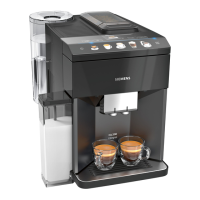
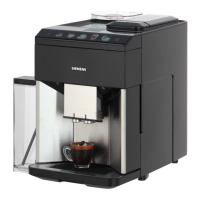
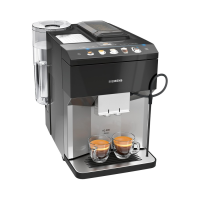
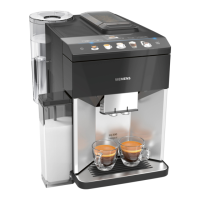
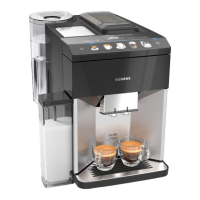
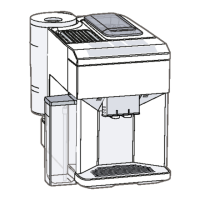
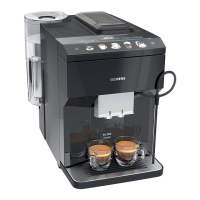
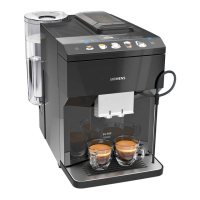
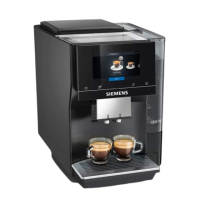
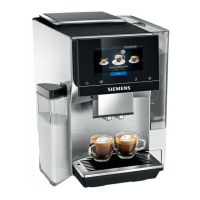
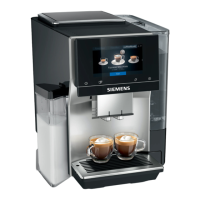
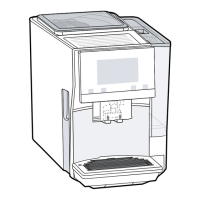
